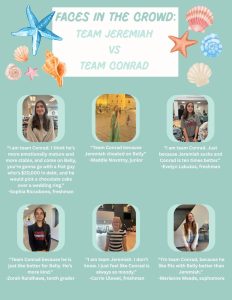An ode to the green bubble: why Android isn’t as bad as iPhone users think
Junior Addison Rasmussen holds his Samsung Galaxy S8. The Galaxy S8 comes with Samsung Experience (formerly TouchWiz) on top of Android. Samsung has drastically improved Samsung Experience, due to criticism since the dawn of Samsung smartphones.
September 10, 2018
iPhones are everywhere around Mason. They are loved by billions of users worldwide, but so are Androids. With Google just releasing beta Android P, I’ve decided to highlight Android, and it’s users around Mason. iPhone users, in a way, have this misconception that they’re “better” or “superior” to the Android community without really knowing anything about Android. Android has paved the way for today’s mobile technology. Android has always had more features and customization than Apple’s iOS found on iPhones, iPads, and iPod Touches. While features and customization are incredible, everything comes with drawbacks too.
Android and iOS have different marketing tactics. Android is open, therefore many manufacturers use Android as their hardware’s operating system. Companies such as Samsung, Huawei, and Nokia use Android for their smartphones. This is a very different tactic than Apple uses. Apple only allows iOS to run on Apple-made products. Because of this, iOS is limited to only iPhones, iPads, and iPod Touches. iOS is also built from the base and up differently. Apple has built in “Apply Only” features, such as Apple’s App Store, iTunes Store, Apple Music, Apple TV, etc. Focusing on the App Store, iOS only has one official App Store; Android has multiple app markets that vary by region and country. Apple mobile devices cannot download programs from outside the official App Store, which makes Apple’s mobile devices inherently more secure.
Within settings on Android, a user may choose to enable “install applications from outside the Play Store,” allowing Android users to download programs from anywhere, like on a PC or Mac. While this feature provides options, it also allows for higher chances of malware being introduced into the operating system. Apple, and now Android, have a security-feature called application sandboxing. Sandboxing basically keeps applications contained so they cannot access other files, programs, or key elements of the OS. This is currently the most effective way of ensuring mobile devices don’t catch viruses. However in 2011, Android lacked this feature entirely.
Apple users have long claimed the following about Android: Android is for “poor” people; Android isn’t secure; Android is ugly and messy; Android is just worse all together. These statements have very little truth to them. It’s true you can find Android on cheap smartphones, and a while ago it would’ve been fair to say Android wasn’t all that secure. However, times have changed, and Android is rather secure nowadays, as long as you don’t go into settings screwing with security settings. Android also allows for third-party antiviruses such as Norton, Kaspersky, McAfee, Avast, ESET, and Qihoo 360. iOS has no such feature, leaving iOS users wondering: “is there a virus on my device?” Android comes in many different styles, for example, Samsung uses Samsung Experience (TouchWiz) and Huawei uses EMUI, which changes how the device looks, interacts, and is used. If you’re not into any of the manufactures choices of design, you can purchase a Google Pixel, which runs pure Android. Pure Android has no fancy bells and whistles, it’s just straight-to-the-point Android.
I spoke with Seniors Erik Bosen and Nikita Solovyov, members of Mason’s Android community, about security.
“You’d have to be an idiot to accidentally install malware on your device… Android is very open, you can install custom ROMS and practically anything you want,” Boesen said.
“I don’t go to sketchy websites [or download sketchy things]. I use [whatever] comes with Verizon on my Samsung Galaxy S8.” Solovyov said.
Basically, if you use your smartphone like a regular person, chances of getting malware are extremely low. It’s those who do stupid things that ultimately catch viruses on their devices.
Of course, Android looks different than iOS, just as Windows looks different than macOS. When comparing aesthetics, this ultimately is a decision that you have to make. Because so many manufacturers use different designs, it is hard to compare iOS with Android. Both serve basic functions such as a phone, camera, photo gallery, and web browser. So claiming Android is messy, isn’t quite fair.
It really could vary, because customization on Android is nearly endless. Anyone’s smartphone could look entirely different than others. It all comes down to what you prefer. If you’re more techy and like to fiddle with settings, Android would be suitable for you. If you want simple, basic, and minimal, iPhone may be right for you. Either way, iOS, and Android can coexist just like Windows and macOS can. If you’re the green bubble, be proud and loud!








